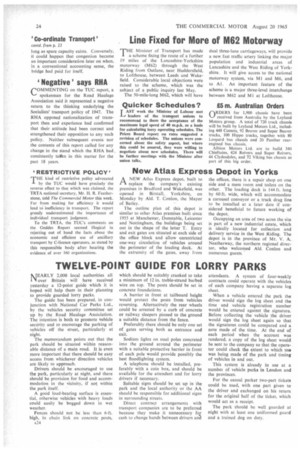TWELVE-POINT GUIDE FOR LORRY PARKS
Page 26

If you've noticed an error in this article please click here to report it so we can fix it.
NEARLY 2,000 local authorities all over Britain will have received yesterday a 12-point guide which it is hoped will help them in their planning to provide guarded lorry parks.
The guide has been prepared, in conjunction with National Car Parks Ltd., by the vehicles security committee set up by the Road Haulage Association. The intention is both to promote vehicle security and to encourage the parking of vehicles off the street, particularly at night.
The memorandum points out that the park should be situated within reasonable distance of a main road. It is even more important that there should be easy access from whichever direction vehicles are likely to approach.
Drivers should be encouraged to use the park, particularly at night, and there should be provision for food and accommodation in the vicinity, if not within the park itself.
A good load-bearing surface is essential, otherwise vehicles with heavy loads could easily be bogged down in wet weather.
Fences should not be less than 6-ft. high, in chain link on concrete posts, s24 which should be suitably cranked to take a minimum of 12 in. treble-strand barbed wire on top. The posts should be set in concrete foundations.
A barrier in front at tailboard height would protect the posts from vehicles reversing. Alternatively the rear wheels could be arrested by a curb of concrete or railway sleepers pinned to the ground a suitable distance from the fence.
Preferably there should be only one set of gates serving both as entrance and exit.
Sodium lights on steel poles concreted into the ground around the perimeter with a suitable protective barrier in front of each pole would provide possibly the best floodlighting system.
A telephone should be installed, preferably with a coin box, and should be available for the attendant and for lorry drivers if necessary.
Suitable signs should be set up in the park and the local authority or the AA should be responsible for additional signs in surrounding streets.
Direct contract arrangements with transport companies are to be preferred because they make it unnecessary for cash to change hands 'between drivers an
attendants. A system of four-weekly contracts could operate with the vehicles of each company having a separate log sheet.
When a vehicle entered the park the driver would sign the log sheet and the time and vehicle registration number would be entered against the signature. Before collecting the vehicle the driver would sign the log sheet again so that the signatures could be compared and a note made of the time. At the end of each period when the account was rendered, a copy of the log sheet would be sent to the company so that the operator could check the extent to which use was being made of the park and timing of vehicles in and out.
This system is already in use at a numbet of vehicle parks in London and the provinces.
For the casual parker two-part tickets could be used, with one part given to the driver and exchanged on his return for the original half of the ticket, which would act as a receipt.
The park should be well guarded at night with at least one uniformed guard and a trained dog on duty.




















































































































